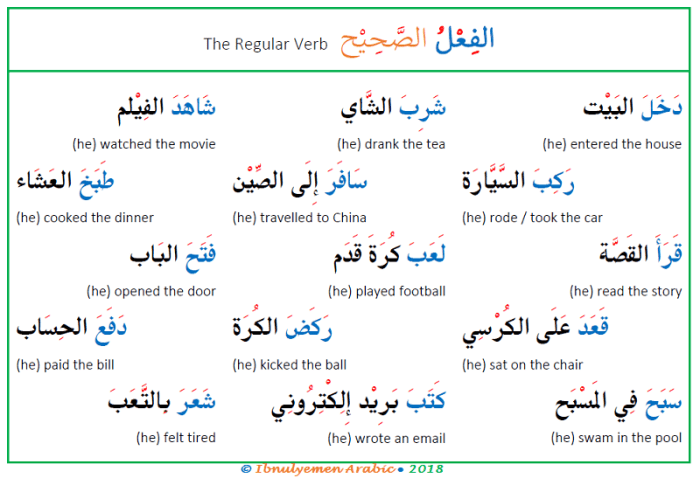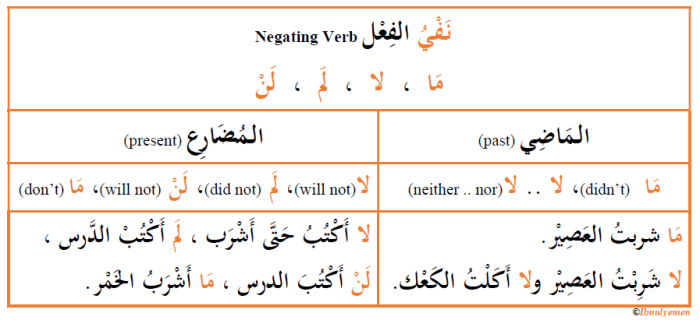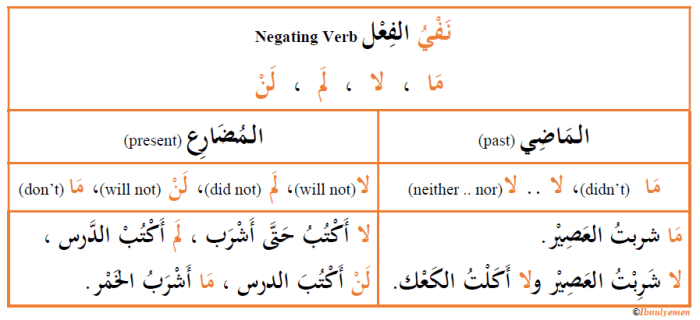Kata kerja larangan dalam bahasa arab disebut ? – Embark on a linguistic journey into the realm of Arabic verbs of prohibition, where we uncover their essence, unravel their grammatical intricacies, and delve into their cultural significance.
In Arabic, verbs of prohibition hold a distinct place in the linguistic landscape, serving as gatekeepers of forbidden actions and conveying a sense of restraint.
Definition of a Verb of Prohibition in Arabic
A verb of prohibition in Arabic is a verbal form used to express the speaker’s command to refrain from an action. It is grammatically constructed using the particle لا (lā) followed by the imperfect subjunctive mood of the verb.
The imperfect subjunctive mood is formed by adding the prefixes ت (ta) for the second person masculine singular, تِ (ti) for the second person feminine singular, and ي (ya) for the third person masculine and feminine singular, as well as the plural forms.
For example, the verb كتب (kataba) “to write” becomes لا تكتب (lā taktuba) “do not write” in the second person masculine singular, لا تكتبي (lā taktubī) “do not write” in the second person feminine singular, and لا يكتب (lā yaktubu) “do not write” in the third person masculine singular.
Types of Verbs of Prohibition in Arabic
In Arabic, verbs of prohibition are classified into two main types: explicitand implicit. Explicit verbs of prohibition are those that explicitly state the prohibition, while implicit verbs of prohibition are those that imply the prohibition through their meaning or context.
Explicit Verbs of Prohibition
Explicit verbs of prohibition are those that contain the negative particle “لا” (la) in their conjugation. The most common explicit verb of prohibition is “حرم” (harama), which means “to forbid” or “to make unlawful.” Other explicit verbs of prohibition include “منع” (mana’a), “نهى” (naha), and “كره” (karaha).
Implicit Verbs of Prohibition
Implicit verbs of prohibition are those that do not explicitly state the prohibition but imply it through their meaning or context. These verbs often express negative emotions or consequences associated with the prohibited action. Some common implicit verbs of prohibition include “خاف” (khafa), “خشي” (khashiya), “كره” (karaha), and “عاقب” (aqaaba).
Conjugation of Verbs of Prohibition in Arabic: Kata Kerja Larangan Dalam Bahasa Arab Disebut ?

Verbs of prohibition in Arabic follow a specific conjugation pattern. To conjugate a verb of prohibition, you first need to identify the root of the verb. Once you have the root, you can add the appropriate prefixes and suffixes to form the conjugated verb.
The following table summarizes the conjugation patterns for verbs of prohibition in Arabic:
| Person | Singular | Plural |
|---|---|---|
| 1st person | لا أفعل (lā afʿalu) | لا نفعل (lā nafaʿalu) |
| 2nd person masculine | لا تفعل (lā tafʿalu) | لا تفعلون (lā tafʿalūna) |
| 2nd person feminine | لا تفعلي (lā tafʿalī) | لا تفعلن (lā tafʿalunna) |
| 3rd person masculine | لا يفعل (lā yafʿalu) | لا يفعلون (lā yafʿalūna) |
| 3rd person feminine | لا تفعل (lā tafʿalu) | لا يفعلن (lā yafʿalunna) |
Use of Verbs of Prohibition in Arabic
Verbs of prohibition in Arabic are used to express the idea of preventing or forbidding an action. They are commonly used in religious contexts, legal documents, and everyday speech.Verbs of prohibition are typically conjugated in the imperative mood, which is used to give commands or instructions.
The imperative form of a verb of prohibition is formed by adding the prefix “لا” (lā) to the present tense form of the verb. For example, the verb “اكل” (akāla) means “to eat.” The imperative form of this verb is “لا تأكل” (lā ta’kul), which means “do not eat.”Verbs
of prohibition can also be used in the jussive mood, which is used to express wishes or requests. The jussive form of a verb of prohibition is formed by adding the prefix “أن” (an) to the present tense form of the verb.
For example, the jussive form of the verb “اكل” (akāla) is “أن لا يأكل” (an lā ya’kul), which means “may he not eat.”
Kata kerja larangan dalam bahasa Arab disebut “nahi”. Seperti dalam bahasa Indonesia, nahi juga digunakan untuk menyatakan larangan atau perintah untuk tidak melakukan sesuatu. Jika kamu tertarik untuk mempelajari lebih lanjut tentang cara mengolah hasil panen, teknik persiapan, dan metode yang tepat, silakan kunjungi Cara Mengolah Hasil Panen: Teknik Persiapan dan Metode untuk informasi lebih lanjut.
Selain itu, memahami nahi juga penting dalam memahami struktur kalimat bahasa Arab yang kompleks.
Examples of Sentences Using Verbs of Prohibition
Here are some examples of sentences using verbs of prohibition:
- “لا تدخن في هذه المنطقة” (lā tudkhun fī hādhihi l-mintaqah) means “No smoking in this area.”
- “لا تسرق” (lā tasriq) means “Do not steal.”
- “أن لا تكذب” (an lā takdhibu) means “May you not lie.”
Comparison with Other Arabic Verb Forms

Verbs of prohibition share some similarities and differences with other Arabic verb forms, such as verbs of permission and obligation.
Similarities
* All three verb forms are derived from the root of the verb.
- They all use the same tense and mood system.
- They can all be used to express commands or requests.
Differences, Kata kerja larangan dalam bahasa arab disebut ?
* Verbs of prohibition are formed using the negative particle “la,” while verbs of permission and obligation use the positive particles “lam” and “ta,” respectively.
- Verbs of prohibition express a negative command or request, while verbs of permission and obligation express a positive command or request.
- Verbs of prohibition are often used in conjunction with other negative words or phrases, such as “ma” or “laysa,” while verbs of permission and obligation are often used in conjunction with positive words or phrases, such as “inna” or “kana.”
Common Mistakes in Using Verbs of Prohibition in Arabic
Verbs of prohibition in Arabic can be tricky for learners, and there are several common mistakes that they often make. This guide will identify these mistakes and provide tips to avoid them, ensuring accurate and effective use of verbs of prohibition in Arabic.
Incorrect Verb Form
One common mistake is using the incorrect verb form. Verbs of prohibition in Arabic are derived from the base verb form IV (المُفاعلة). Learners may mistakenly use other verb forms, such as form I (الفاعل) or form II (المفاعل), which can lead to incorrect meanings or grammatical errors.
Tip:Always ensure that the verb of prohibition is in the correct form IV (المُفاعلة) to convey the intended meaning of prohibition.
Lack of Negation
Another mistake is omitting the negation particle “لا” before the verb of prohibition. The negation particle is essential for expressing prohibition, and its absence renders the sentence incorrect and changes the meaning.
Tip:Remember to include the negation particle “لا” before the verb of prohibition to convey the intended prohibition.
Incorrect Object Placement
In Arabic, the object of a verb of prohibition typically comes after the verb. However, learners may mistakenly place the object before the verb, which can lead to confusion and incorrect interpretation.
Tip:Always place the object of a verb of prohibition after the verb to maintain correct Arabic grammar.
Confusion with Other Verb Forms
Verbs of prohibition in Arabic can be similar to other verb forms, such as verbs of prevention or verbs of advice. Learners may confuse these verb forms and use them interchangeably, leading to incorrect meanings.
Tip:Understand the subtle differences between verbs of prohibition, prevention, and advice to use them accurately in different contexts.
Incorrect Tense
Verbs of prohibition can be used in different tenses, such as the present, past, and future. Learners may mistakenly use the incorrect tense, which can affect the meaning of the sentence and lead to grammatical errors.
Tip:Choose the correct tense for the verb of prohibition based on the context and the intended meaning of the sentence.
Exercises and Activities for Practicing Verbs of Prohibition in Arabic
To enhance proficiency in using verbs of prohibition in Arabic, engaging exercises and activities are essential. These activities aim to provide learners with ample opportunities to practice constructing and utilizing prohibition sentences accurately and confidently.
Kata kerja larangan dalam bahasa Arab disebut nahi, yang biasanya ditandai dengan awalan “la”. Untuk memperdalam pemahaman tentang nahi, disarankan untuk membaca panduan lengkap tentang cara berzikir sesuai ketentuan, yang tersedia di Cara Berzikir Sesuai Ketentuan: Panduan Lengkap . Panduan ini akan membantu Anda memahami lebih lanjut tentang larangan dalam bahasa Arab dan cara menggunakannya dengan benar.
Written Exercises
- Sentence Completion:Provide learners with incomplete sentences containing verbs of prohibition and ask them to fill in the missing words to complete the prohibition.
- Translation Exercises:Translate sentences from English to Arabic, focusing on using verbs of prohibition correctly.
- Short Story Writing:Assign learners to write short stories that incorporate verbs of prohibition in various contexts.
Oral Exercises
- Dialogue Creation:Engage learners in pair work to create dialogues that involve using verbs of prohibition in different situations.
- Role-Playing:Divide learners into groups and assign them roles. Have them act out scenarios where they need to use verbs of prohibition appropriately.
- Oral Presentations:Ask learners to prepare short oral presentations on topics related to verbs of prohibition, demonstrating their understanding and usage.
Cultural Context of Verbs of Prohibition in Arabic
Verbs of prohibition in Arabic hold significant cultural significance, reflecting deeply rooted values and norms within Arabic-speaking societies. These verbs serve as linguistic markers of what is considered unacceptable or forbidden, shaping social behavior and interpersonal communication.
One key aspect of the cultural context of verbs of prohibition is their role in preserving social order and maintaining respect for authority. The use of these verbs conveys a sense of disapproval and serves as a warning against violating established norms.
For example, the verb ḥarrama(to forbid) is often used in religious contexts to prohibit certain actions or behaviors that are considered sinful or morally wrong.
Another important aspect of the cultural context of verbs of prohibition is their use in expressing politeness and deference. By employing these verbs, speakers can politely request others to refrain from certain actions or behaviors. This is particularly evident in formal settings or when interacting with individuals of higher social status.
For example, the verb man’a(to prevent) can be used to politely ask someone to stop doing something that is causing inconvenience or discomfort.
Verbs of prohibition also play a role in shaping cultural perceptions of right and wrong. The use of these verbs reinforces societal expectations and helps to define what is considered acceptable or unacceptable behavior. By prohibiting certain actions or behaviors, these verbs contribute to the formation of moral and ethical values within Arabic-speaking communities.
Cultural Norms Reflected in Verbs of Prohibition
- Respect for authority:Verbs of prohibition convey a sense of disapproval and serve as a warning against violating established norms, reflecting the importance of respecting authority figures and social hierarchy.
- Preservation of social order:These verbs help to maintain social order by prohibiting actions that are considered disruptive or harmful to the community.
- Expression of politeness:Verbs of prohibition can be used to politely request others to refrain from certain actions or behaviors, demonstrating respect and deference.
- Formation of moral values:By prohibiting certain actions or behaviors, these verbs contribute to the formation of moral and ethical values within Arabic-speaking communities.
Resources for Learning Verbs of Prohibition in Arabic

To enhance your understanding of verbs of prohibition in Arabic, various resources are available. Each resource offers unique advantages and caters to different learning styles. Let’s explore some of the most recommended options.
Textbooks
Textbooks provide a structured and comprehensive approach to learning verbs of prohibition. They typically include clear explanations, grammar exercises, and vocabulary lists. Some popular textbooks include:
- Arabic Grammar for Beginnersby Khalil Semaan
- Modern Standard Arabic Grammar: A Learner’s Guideby Karin C. Ryding
- Al-Kitaab fii Ta’allum al-Arabiyya: A Textbook for Beginning Arabicby Kristen Brustad, Mahmoud Al-Batal, and Abbas Al-Tonsi
Websites
Websites offer interactive and accessible learning experiences. They provide online lessons, grammar exercises, and forums for discussion. Some reputable websites include:
- ArabicPod101: Offers free lessons, podcasts, and a grammar guide covering verbs of prohibition.
- Madinah Arabic: Provides interactive lessons, downloadable materials, and a comprehensive grammar section.
- LangMedia Arabic: Offers online courses, grammar tutorials, and a verb conjugator for practicing verb forms.
Videos
Videos can be an engaging way to learn verbs of prohibition. They provide visual demonstrations and allow you to hear the correct pronunciation. Some useful YouTube channels include:
- Learn Arabic with Maha: Offers clear and concise video lessons on Arabic grammar, including verbs of prohibition.
- Arabic 101 with Abdallah: Provides short and informative videos covering essential Arabic grammar topics.
- ArabicPod101: Offers a video series on verbs of prohibition, including conjugation and usage examples.
Summary
Our exploration of Arabic verbs of prohibition has shed light on their grammatical structure, diverse types, and nuanced usage. By understanding their intricacies, we gain a deeper appreciation for the expressive power of the Arabic language and its ability to convey subtle shades of meaning.
Essential FAQs
What is the grammatical structure of a verb of prohibition in Arabic?
Verbs of prohibition in Arabic typically follow the pattern “لا + مضارع مجزوم,” where “لا” is the negative particle and “مضارع مجزوم” is the jussive mood of the verb.
How do you conjugate verbs of prohibition in Arabic?
The conjugation of verbs of prohibition in Arabic varies depending on the person, number, and gender of the subject. A table summarizing the conjugation patterns is provided in the content.

